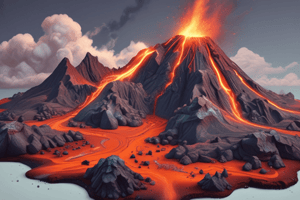Podcast
Questions and Answers
What is the term for the rocks and debris thrown into the air by a volcano?
What is the term for the rocks and debris thrown into the air by a volcano?
- Tephra (correct)
- Lava
- Plume
- Magma
Where does molten rock exist under the Earth's crust or the crust of other planets and moons?
Where does molten rock exist under the Earth's crust or the crust of other planets and moons?
- As lava
- As tephra
- In the mantle
- As magma (correct)
What do we call molten rock when it pushes up and escapes through a vent?
What do we call molten rock when it pushes up and escapes through a vent?
- Lava (correct)
- Magma
- Plume
- Tephra
Which type of eruption is known for having a large amount of gas, dust, ash, and lava blown out from a central crater?
Which type of eruption is known for having a large amount of gas, dust, ash, and lava blown out from a central crater?
What type of volcano is Mount Pelée known for?
What type of volcano is Mount Pelée known for?
Which type of eruption is characterized by a large solid plug that shoots out to begin the eruption?
Which type of eruption is characterized by a large solid plug that shoots out to begin the eruption?
How is Iceland known based on the text?
How is Iceland known based on the text?
What is the main composition of magma?
What is the main composition of magma?
Which type of volcano is built from slow, thin layers of fluid lava?
Which type of volcano is built from slow, thin layers of fluid lava?
What is an effusive eruption characterized by?
What is an effusive eruption characterized by?
Flashcards are hidden until you start studying
Study Notes
- The Earth's crust is a thin shell that covers 1% of the Earth's volume, and it is where volcanoes are found.
- Volcanoes come in different shapes and sizes, depending on the amount of pressure in the magma chamber and the difficulty in breaking through the surface.
- There are four main types of volcanoes: cinder cones, composite volcanoes, shield volcanoes, and lava domes.
- Cinder cones are simplest, built from congealed lava ejected from a single vent, and have violent eruptions.
- Composite volcanoes are steep-sided, symmetrical cones built with layers of lava flows and cinders, and have a crater at the summit.
- Shield volcanoes have a flatter, rounded shape and are built from slow, thin layers of fluid lava.
- Lava domes are smaller, with lava too thick to flow far, and they expand from inside to out as the lava cools and hardens.
- Magma is made mostly of aluminum, calcium, iron, magnesium, oxygen, potassium, silicon, sodium, and titanium.
- Volcanic activity can include hot gas, lava, or perfectly still, steady flows.
- Volcanic activity happens for various reasons, including instability due to shifting tectonic plates or magma chambers.
- An eruption is a sudden discharge of volcanic material, which can be unexpected and violent.
- Effusive eruptions are less violent and contain more liquid magma, while explosive eruptions are much more violent and spew thicker magma and rocks into the air.
- Hazards of volcanic eruptions include gas clouds, acid rain, tephra ash, lava flow, landslides, pyroclastic flows, tsunamis, earthquakes, and loss of plants and habitats.
- Iceland, which sits between two continental plates, is expanding every year and has more than 130 volcanoes.
Studying That Suits You
Use AI to generate personalized quizzes and flashcards to suit your learning preferences.




